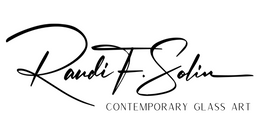Glassblowing is a like a finely choreographed dance, where everyone has their part to play and we all work together towards one fluid creation.
Today we're creating an Azul Kauri for Chasen Gallery in Sarasota, Florida.
Before we begin the team gathers to discuss the game plan so everyone has an overview of the steps it takes to create the piece, and so that each of us is clear on what we will be doing. We discuss the color palette and lay out the glass that we will use to color the piece.

We use powdered glass, glass cane (long thin strands), glass chips and shards from Germany to create the layered effects of color, and sometimes silver or gold foil from Italy or Japan. The Azul Kauri we're making today is composed of 17 layers of colors to create the deep blue coloration and layers of silver foil from Japan.
Powdered Glass for Coloration

Thin Strands of Glass Cane

We begin by gathering a small amount of clear glass on the blowpipe in the furnace, and start forming it into a smooth round shape by blowing through the pipe while forming it by hand with a newspaper-lined pad.
Glass on the blowpipe

We continue to add to the piece, adding layers of glass, and flashing (heating) it between each layer in the glory hole, each layer adding more coloration based on what the design calls for.
Adding layers of powdered glass to give the Kauri its rich deep blue color

Layer by layer powder and silver foil from Japan are added as we shape the piece.
The pipe is always in motion, whether in the glory hole or on the bench, being swung around or marvered (rolled on the table), we keep it moving so that the piece takes shape in the form that we are looking for.
An up close photo of the Glory Hole

The Kauri are created by merging two separate pieces together.
One person will work on the smaller piece, nicknamed the worm, by adding layers of silver foil and slowly lengthening the piece using gravity to elongate it to about 19".
George using gravity to lengthen the worm while Randi lengthens the main piece


George (left) flashing the worm while Mike gathers another layer on the main piece

The other person is working the main piece, lengthening it and shaping it, splitting it in the center to make two ventricles.
George marvering the worm while Randi marvers the main piece


Adding silver foil layers to the worm

George and Mike adding more glass layers to the worm

Randi and Mike shaping the main piece using a wood paddle and newspaper pads

Then we make a jack line, which is a constriction in the glass near where the pipe attaches. Without it, the piece will not come off the blowpipe.
Creating the jack line on the main piece

After another flash, its time for more shaping.
Mike and Randi using cork paddles to shape the piece

Creating Ventricles in the middle of the main piece

When both people are feeling ready, they come together and join the two long thin pieces, bending the thinner one so that it turns away and looks like the Kauri tree that inspired it.
The team works together to join the two pieces

Then we take another flash, where its heated in the glory hole so that the composition of the glass is just right to work with.
Up close photo of the glory hole

After we take it out, we flatten the bottom by resting it on a wooden paddle.

Next we transfer the piece off of the blow pipe to a punty rod, so we can begin to work on the other side of the piece, opening it up and encouraging its arms to be outstretched towards the sky like a tree.
Attaching the punty rod to the main piece

The transfer takes great coordination and communication with the team, aligning the two pieces just so.
Removing the blowpipe

Randi is like the master gaffer, working the piece, choreographing the dance, and making decisions about shape, gesture and color.

In between every move, we are heating the piece in the glory hole (reheating chamber) or with a blow torch.

After another flash, we work the piece to make sure that the overall gesture and design is what we are looking for.

When everything looks good, we break it off the punty rod and place it gently in the annealer where it will stay for 8 hours at 910 degrees allowing every atom to become 910 degrees so that it can cool slowly over two more days.
George preparing to catch the Kauri while Randi applies water to the jack line

The annealer

A Lapis and Glacier ready to be removed from one of our annealers

Then it goes to Brett, our cold worker, who will spend an entire day cutting & polishing the piece.

And finally, a work of art is revealed

